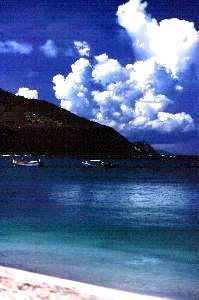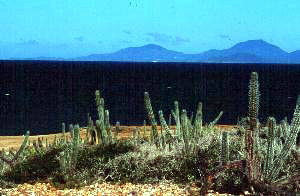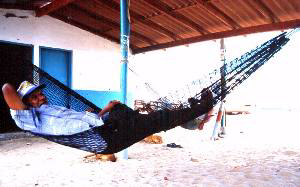|
BEACH BLANKET BABYLON Versions of this article appeared in the May 2001 edition of New Law Journal as well as in the Caracas Daily Journal in 2000
It's yet to reach the "English
breakfast like what you get back home" stage, but it won't
be long. I found a beach bar run by an English guy called Mike,
replete with Engerland football scarves hanging from the thatched
palm roof and a picture of Tony Blair giving it the thumbs up. It
was Happy Hour from 5 to 7pm. Piña coladas all round, until the
shipment of John Smiths bitter from back home arrives, anyway.
From one high bend, the
prospect includes a five-star hotel in the foreground, its 18-hole
golf course landscaped to a tee. It somehow looks unreal, more like
an architects' draft than the real thing. An angular, reflective-glass,
cold structure beamed down to this tropical land. It's called, of
all things, Isla Bonita, and I was told the winds are too strong
for golf during the sport's high season. The result? Its 120 rooms
are hollow and empty. I expect the investors have duly supplied
the hotel's architect with a pair of concrete slippers for his next
'dive'. WRATH OF THE ICE-CREAM PARLOUR I was befriended later in the town of Juangriego (JohnTheGreek,
named, so the story goes, after a Greek fisherman), famous for its
Technicolour sunsets, by an entertaining man called Carlos. He spoke
several European languages, had a slightly bouffant hairdo and an
early-40s paunch which suited his laid-back character. He was opening
a tapas bar called Gitano. The best gem of information he gave me
concerned the vast four-star 'Dunes' resort I'd shlepped round that
day. He was the catering manager there until a few months ago. His
orders were not to spend more than $2 per person on any one meal.
That meant sandwiches for lunch and pasta for dinner, day in, day
out. Every day he had queues of disgruntled package tourists outside
his office. Think about that next time you leaf through a Club 18-30
brochure... In the town of El Cercado, not far from the Frank's place, the village
women all produce ceramics to sell to the tourists. My favourite
was a larger-than-life-size model of a robust black mamma, tits
out to here, arse out to there, bowl of fruit on her head, large
looping earrings and a orange dress. Utterly non-PC, but the kind
of thing that makes you slam your brakes and reverse to get a better
look. I bought the four-inch, scaled down version, but I tell you,
it just ain't the same as the real thing. Back west of Porlamar, the loftily-named Valle del Espíritu Santo
(Holy Spirit Valley) is dominated by the sanctuary to the Virgin
of the Valley, and its neo-Gothic chapel, painted pink. People come
from all over the island and eastern Venezuela to pay homage to
the Virgin, and thank her for favours. They leave all sorts of things
behind for the Lady, and a museum had to be erected to house all
the offerings. These range from the pearl-incrusted, ornate and
valuable, to car number plates, tins of tuna, high-school diplomas,
and little silver or gold limbs (for health cures). As an agnostic,
I shunned leaving anything but my disdain for such superstition.
But, having wandered around the museum for a while, and got back
in my jeep, I couldn't shake that nagging feeling maybe I should
have left my spare car key, or a notepad. Just in case -- as Pascal
might have wagered... On my last days I visited another mecca of sorts. Europeans and
North Americans come to El Yaque to pay homage to the God of Wind.
El Yaque is probably South America's prime beach for windsurfing,
where winds howl at Force 6 for half the year. In little over ten
years it's gone from the 'taxi-driver beach' (where the airport
taxi drivers would come for a nap) to boast about ten hotels, all
confusingly called things like 'Windsurfers' Paradise', 'El Yaque
Paradise' and 'Windsurfers' Oasis'. I managed to blag an hour's
windsurfing, which I soon converted into six, and stayed at a place
set back from the beach called Casa Viento. |
|
||||
 |
 |
 |
 |
|
 |
All material on this site is © 2000-7 Dominic Hamilton and The Globe Pequot Press. Dominic Hamilton Home |



